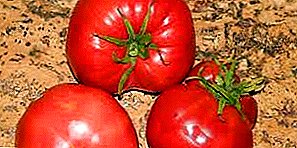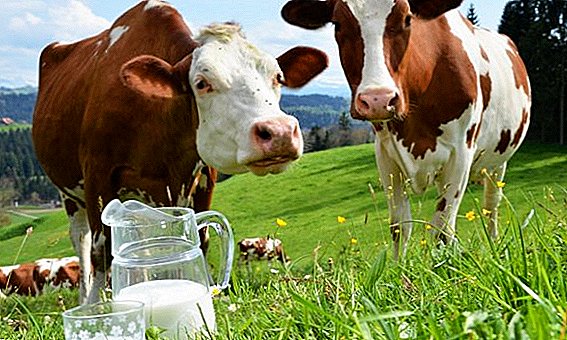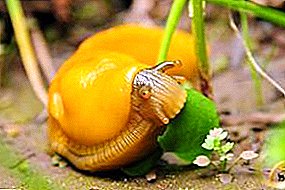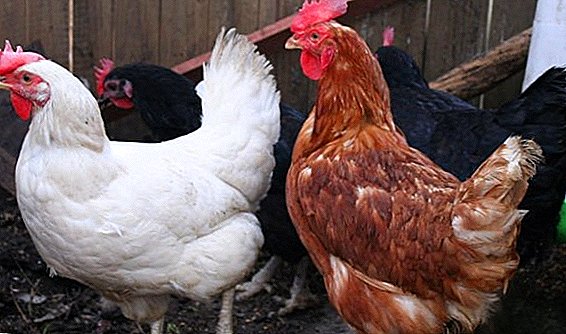 The progenitors of domestic chickens, wild bank chickens, gave 4-13 eggs. Over several millennia of their domestication, this figure has increased significantly. Now a good layer is able to lay about 200 eggs a year. This is the merit of breeders who do not stop working on the creation of new breeds, hybrids as much as possible, improving their characteristics. Not so long ago, a new cross was introduced, which was greatly loved by all poultry farmers. This chickens Shaver. Their features will be described later in the article.
The progenitors of domestic chickens, wild bank chickens, gave 4-13 eggs. Over several millennia of their domestication, this figure has increased significantly. Now a good layer is able to lay about 200 eggs a year. This is the merit of breeders who do not stop working on the creation of new breeds, hybrids as much as possible, improving their characteristics. Not so long ago, a new cross was introduced, which was greatly loved by all poultry farmers. This chickens Shaver. Their features will be described later in the article.
Selection
The Dutch company Hendrix Genetics Company was tasked with: bringing out unpretentious birds with good egg production rates. It took the company several decades to create an excellent hybrid called the Shaver at the end of the twentieth century. He was distinguished not only by unpretentiousness and good egg production, but also by a well-developed incubation instinct. 
Did you know? The world leaders in the production of chickens are the United States (18.29 million tons per year).
Description and features
In the hybrid, there are three varieties that differ in color. Shaver Brown (brown), Shaver Black (black), Shaver White (white). All other characteristics are identical. Although some poultry farmers claim that blacks are the largest, Brown is a bit smaller, and White is the smallest.
Check out such cross-country chickens as: ROSS-708, Master Gray, Hubbard, Dominant, Amrox, Hercules, Hisex, Avicolor, Rhodonite, Loman Brown and Hungarian Giant
Appearance and physique
All representatives of the cross Shaver small size. Females weigh 2 kg on average, males are 25-30% heavier. They look the most common, nothing remarkable. The body is small, with a light bone structure. Chest and abdomen slightly plump. In the hens, the belly is more voluminous than in cocks. The back is all concave, and the males are also elongated. The neck is short. Paws of medium length, without plumage, change with age from yellowish or orange to white with light blue.  The tail of the females is slightly lowered, while the males are raised. The roosters also highlight their proud posture. The young eyes are expressive, rich dark orange color. With age, the brightness is slightly lost. Comb medium size leaf-shaped. In roosters, he stands upright, in hens he falls a little on his side. Earrings bright red color. The lobes are white. Beak all powerful, with a yellowish tinge.
The tail of the females is slightly lowered, while the males are raised. The roosters also highlight their proud posture. The young eyes are expressive, rich dark orange color. With age, the brightness is slightly lost. Comb medium size leaf-shaped. In roosters, he stands upright, in hens he falls a little on his side. Earrings bright red color. The lobes are white. Beak all powerful, with a yellowish tinge.
Color
As we have said, representatives of the Cross Shaver White are painted white, Shaver Black is black, Shaver Brown is brown. Brown has white spots on the tail and wings.
Did you know? Female chickens Chicken Shaver fledge earlier than male chicks. These differences are noticeable already a day after birth, which makes it easy to determine the sex of chicks.
Character
Chickens Shaver are peace-loving and very calm. They will not interfere with other relatives, so keeping them in a common henhouse with the same peace-loving birds is very simple. But despite the phlegmatic nature, they are rather restless. This is more about males. They are very curious and always strive to fly. 
Hatching instinct
Unlike their hybrid congeners, the Shaver layers have not lost their incubation instinct. They easily sit on sticks and take care of their brood. Of course, among them, as well as among people, there are windy individuals and quite often. Therefore, to acquire an incubator still does not hurt.
Productivity Indicators
This cross, perhaps, is one of the most productive among the egg breeds.
It will be interesting to get acquainted with the rating of egg breed chickens.
Egg production and when they begin to rush
Puberty in layers begins early, at 4-5 months. From this point on, they begin to lay eggs. At first this process is not regular. But after a couple of weeks it is getting better. Eggs are medium in size, weighing about 55-62 grams. For the year on average, one layer gives 200-220 eggs. Some sources cite other numbers: 350-400 pieces. The color of the shell depends on the color of the cross.  Black and White are white for Brown and Brown for brown. Defective eggs bring only 1% for the entire productive period. Survival of chicks at the highest level: 96-98%. The survival rates of young stock below - 80-82%. Of course, all these indicators are fair with proper bird care.
Black and White are white for Brown and Brown for brown. Defective eggs bring only 1% for the entire productive period. Survival of chicks at the highest level: 96-98%. The survival rates of young stock below - 80-82%. Of course, all these indicators are fair with proper bird care.
Important! The chicken eggs of the Shaver are more saturated with Omega-3 and Omega-6 acids than in other layers.
Precocity and taste of meat
Hybrids gain weight quickly. At 18 weeks they weigh 1.3 kg, and at 23 weeks - 1.85 kg. Up to two kilograms get to 52 week. With such a weight, the useful meat yield is minimal. Yes, and his taste leaves much to be desired, as egg chickens are muscular.
Conditions of detention
The content of Cross Shaver is unpretentious. For him, the main thing is not the room, but the diet.
Find out how much chicken lives: home, layer, broiler.
Requirements for the room
Chickens can live well in the hen house and in cages. The dwelling does not need special equipment. Cross is frost-resistant, so it can live even in an unheated hen house. The main thing is that there should be no drafts, it was dry and the floor was covered with a layer of hay, straw, and dry foliage. Be sure to need good ventilation in the room.  You should also take care of nests. They can be made in ordinary boxes and lined with hay. When constructing perches, it should be borne in mind that it should be of medium size and at least 40 centimeters of space should be allocated to one individual.
You should also take care of nests. They can be made in ordinary boxes and lined with hay. When constructing perches, it should be borne in mind that it should be of medium size and at least 40 centimeters of space should be allocated to one individual.
Courtyard for walking
Chickens of this hybrid love to fly. Therefore, the courtyard should be protected with a high fence.
How to endure winter cold
To a temperature of + 5-7 ° C, the hens feel great in an unheated room and continue to lay eggs. With a further decrease in temperature, infrared lamps should be installed above the perches. For chickens, it is detrimental when the temperature drops below + 28 ° C. 
Important! Do not recommend releasing birds for a walk when the temperature reaches -10°WITH.
What to feed
In nutrition, the hybrid is not picky. It consumes 5-10% less per day than other egg hybrids.
Chickens
A couple of first days in the menu of chickens there is only a boiled crushed egg, greens and cereals. On the third day of life, you can enter the cottage cheese, yogurt. Cottage cheese must be dry and not fat, so as not to get chicks stuck in small beaks. Also, to normalize digestion in chicks, there should be a tank with sand near the trough. It must be pre-ignited for about 10 minutes in a frying pan for disinfection. Five-day chicks can already be given special feed corresponding to their age. 
Adult chickens
The diet of adult birds must be built on a balanced combination of animal feed, grain and vegetable food. In the morning, it is desirable to give a mix of grains, meat and bone, fish meal, crushed shells, chalk, a pinch of salt. You can also add carrots, silage, beets. Be sure to in the diet should be fresh greens. In winter, it will be replaced by grass meal. Feed better three times a day. And in the evening it is desirable to give wet food (vegetables, greens). Near the feeders should always be drinking.
Advantages and disadvantages
Pluses of cross-country:
- high level performance;
- endurance;
- good health;
- unpretentiousness, frost resistance;
- high rates of survival;
- eggs with durable shells and rich in fatty acids;
- peaceful nature.
Disadvantages:
- often the hens refuse to breed;
- with improper care during the period of molting cannibalism appears.
 You are familiar with the features of the Dutch layers. As you can see, they are very unpretentious and do not cause problems with breeding. Therefore, if you plan to start an eggplant, then opt for this hybrid, as the best in your group.
You are familiar with the features of the Dutch layers. As you can see, they are very unpretentious and do not cause problems with breeding. Therefore, if you plan to start an eggplant, then opt for this hybrid, as the best in your group.











